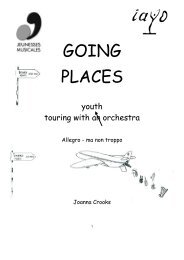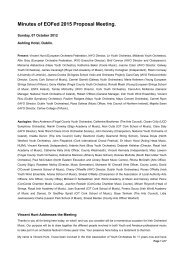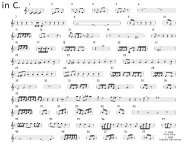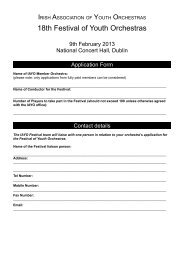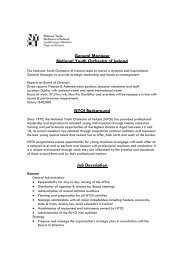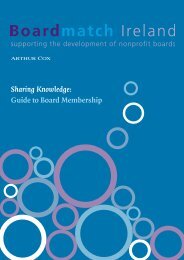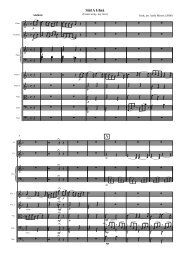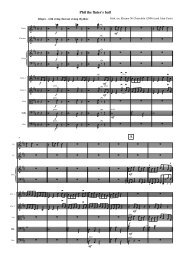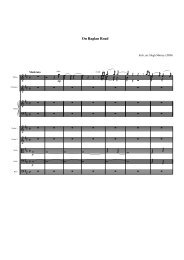A SOUND EAR II - Association of British Orchestras
A SOUND EAR II - Association of British Orchestras
A SOUND EAR II - Association of British Orchestras
Create successful ePaper yourself
Turn your PDF publications into a flip-book with our unique Google optimized e-Paper software.
A <strong>SOUND</strong> <strong>EAR</strong> <strong>II</strong><br />
Orchestra <strong>of</strong> the Royal Opera House<br />
The Orchestra <strong>of</strong> the Royal Opera House is a large group <strong>of</strong> salaried musicians who serve both the Royal Opera<br />
and the Royal Ballet and other activities within the House, including Education and small scale work in the Linbury<br />
Theatre. The total number <strong>of</strong> players exceeds one hundred but the schedule demands rotation and therefore it would<br />
be rare for all members to be called together. The closest it gets is during Wagner’s Ring Cycle when all players would<br />
be involved in at least two out <strong>of</strong> four operas.<br />
At the Royal Opera House there is a management absolutely determined to make a contract with the musicians to<br />
monitor, record and control exposure to noise levels on an individual basis. Measures are being taken to explore and<br />
install the best and latest physical levels <strong>of</strong> protection at the ROH and it is apparent that everything that can be done is<br />
being done. Audiometric testing is available to all members and confidential health pr<strong>of</strong>iling is well under way.<br />
Musicians <strong>of</strong> the Orchestra <strong>of</strong> the Royal Opera House were very open with their comments and it was possible<br />
to form a very full picture <strong>of</strong> the work being carried out. In September 2007 it was possible to observe a whole day <strong>of</strong><br />
sessions about health and safety and noise at the Royal Opera House. These sessions, which were aimed at the whole<br />
orchestra and immediate orchestra management, were arranged for small groups over a period <strong>of</strong> two or three weeks<br />
and included periods <strong>of</strong> training, presentation and discussion. These events are established as a regular part <strong>of</strong> the<br />
‘Healthy Orchestra’ regime at Covent Garden.<br />
The challenges <strong>of</strong> working in the confines <strong>of</strong> a pit are so great that solutions cannot be found without taking full<br />
advantage <strong>of</strong> the best pr<strong>of</strong>essional help available in the acoustics field. The ROH is leading the way in this respect and<br />
other opera and ballet orchestras will benefit from the sharing <strong>of</strong> the outcomes. ‘In house’ responsibility on a day to<br />
day basis is also crucially important. An Orchestra Operations Manager has recently been appointed and he comes<br />
with experience <strong>of</strong> the Sydney Opera House, where much has been done, both practically and experimentally, over the<br />
last few years in the control <strong>of</strong> noise. He is tasked, among other things, with advising the Orchestra Director, working<br />
out seating plans and organising the monitoring <strong>of</strong> noise levels in the pit.<br />
Quote from a violinist: “He seems clued up ... (and) is already producing specimen rotas for individual players, based on their<br />
potential exposure. In order for these to be accurate, measurements are planned within the pit to map the potential exposure in<br />
any area. It looks like a complete statistical nightmare to me ... However they are attempting it!”<br />
Critics will say that the Royal Opera is well funded (relatively) so the orchestra management ought to be ahead <strong>of</strong> the<br />
game. Maybe that is fair comment, but observations confirm that it is the commitment and the quality <strong>of</strong> the work<br />
being done that is impressive and this cannot be underestimated. Even the cynics in the orchestra, and there are some,<br />
agree that the management seems to be doing everything possible to maintain momentum. They have come a long way<br />
since the ABO training and are taking further pr<strong>of</strong>essional advice from many quarters. They do not have a formal noise<br />
team but there are those within the orchestra who have been involved from the beginning and continue to be part <strong>of</strong><br />
the team along with the elected representatives and H&S pr<strong>of</strong>essionals within the House.<br />
33<br />
London Philharmonic Orchestra<br />
The London Philharmonic Orchestra was founded in 1932 by Sir Thomas Beecham from the best players in the<br />
country, with the intention <strong>of</strong> rivalling those in Vienna and Berlin. In 1990 it became a Resident Orchestra at the<br />
Royal Festival Hall in London. The Orchestra’s versatility is evident from its pioneering education and community<br />
programme, its international trail blazing tours and its comprehensive recording catalogue. The Orchestra is resident at<br />
Glyndebourne Festival Opera during the summer months.<br />
The Orchestra is self-governing and seven players serve on the board along with seven non-executive members. The<br />
core membership is between 85 and 90 players.<br />
The Healthy Orchestra Charter (http://www.abo.org.uk) and the publication on the web <strong>of</strong> the Sound Advice<br />
consultation document (http://www.soundadvice.info) has been the spur to a flurry <strong>of</strong> activity at the London<br />
Philharmonic Orchestra. On their own admission, the management and players coasted along after the ABO training,<br />
providing standard ear plugs and screens on request and generally acknowledging the need to move towards a policy.<br />
But, in addition to the effect <strong>of</strong> Sound Advice, playing in a smaller London space during the closure <strong>of</strong> the Royal Festival<br />
Hall has also encouraged new dialogue about noise levels, seating and repertoire.<br />
A team, made up <strong>of</strong> players and staff, is in the process <strong>of</strong> drawing up the Orchestra’s policy response to the Sound<br />
Advice consultation, and a new handbook containing general working and H&S policies has been published. A specific<br />
policy on noise management will be added when it has been agreed. Matters under discussion include the damping <strong>of</strong><br />
sound at Henry Wood Hall (the Orchestra’s principal rehearsal space), following up on acoustic tests at Glyndebourne,



